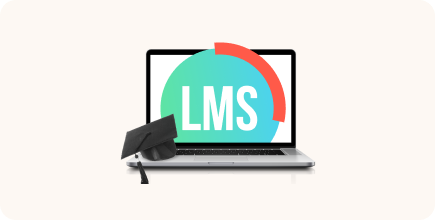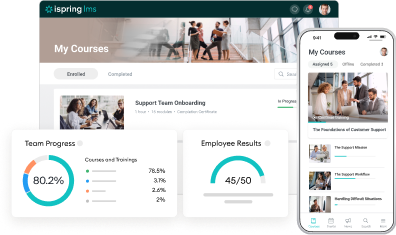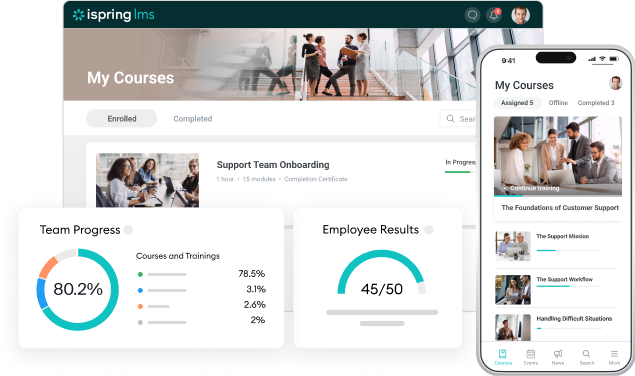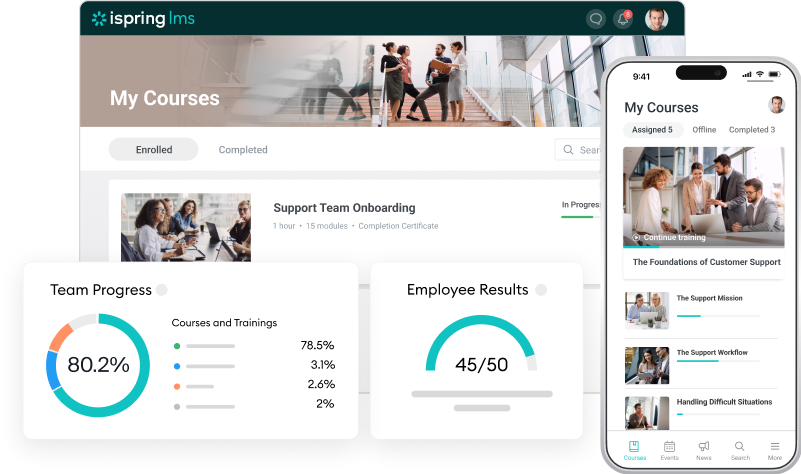How to Calculate LMS ROI: A Comprehensive Guide for Organizations

A learning management system (LMS) is a powerful tool that helps organizations streamline training and development. It offers various benefits, such as improved employee performance, compliance tracking, and cost savings. However, to truly understand the value of an LMS, it’s crucial to measure its return on investment (ROI). ROI is a key metric that evaluates the efficiency and profitability of your LMS investment.
In this article, we’ll explore what LMS ROI is, how to calculate it, and what factors affect it. And feel free to download our LMS ROI calculator template!
What is the ROI of an LMS?
ROI is a measure of the profitability of an investment, expressed as a percentage. For a learning management system, ROI indicates how much return you get from the system compared to the cost of implementing and maintaining it. A high ROI means the LMS is providing significant value compared to its cost.
Measuring the ROI of an LMS helps organizations determine the effectiveness of their training programs. It provides insights into how well the learning platform is performing and helps companies make informed decisions about future investments in their learning and development initiatives.
How to Calculate LMS ROI
To measure the ROI of a learning management system, you need to identify all LMS-related expenses (not only subscription costs but also your investments in implementation and training development), quantify the benefits that the LMS provides to your business, and calculate the ROI using a formula.
The process is fairly straightforward. However, it’s important to not overlook any metrics for the most accurate calculation.
Let’s look at each step. To illustrate some points, we’ll use statistics from our recent research findings, “The State of Online Corporate Training in 2024.”
Step 1: Identify costs
Begin by identifying all the costs associated with the LMS. These costs can be divided into several categories:
- Initial costs. This includes the purchase price of the LMS software, any setup fees, and expenses related to data migration.
- Implementation costs. These involve costs for customizing the LMS, integrating it with other systems, and the time spent by IT staff on implementation.
- Training costs. These are costs related to hiring training administrators and instructors, as well as developing online training courses or purchasing them from third-party companies.
- Ongoing costs. Here we include subscription or licensing fees, maintenance costs, and any expenses associated with updates and support.
How much does all of this typically amount to? The overall cost varies based on the size of the company and its specific needs. However, according to our research, 40% of organizations spent less than $50,000 on employee training in 2023. So, chances are, you will have a number within that range.
Step 2: Quantify benefits
An LMS provides companies with numerous benefits, from reduced travel expenses for employees who conduct customer training and avoiding compliance risks to increased employee retention and enhanced performance.
The tricky part is that you can’t quantify all of them. For example, an LMS makes it possible for the company to upskill its remote teams. This makes the company much more attractive for potential job candidates who want to work remotely and value skill development. So, if they have to choose between joining a company with an LMS or one without it, they’ll select the former.
While this is a significant benefit, it’s difficult to measure the impact that an LMS can make in tangible metrics. And yet, if you ignore it, you won’t have a full understanding of the return you get from investing in a learning management solution.
This is why we believe it’s important to classify all the benefits of an LMS into tangible and intangible and consider the intangible ones as well before deciding whether or not to invest in an LMS.
Here are the most common LMS benefits, listed as tangible or intangible:
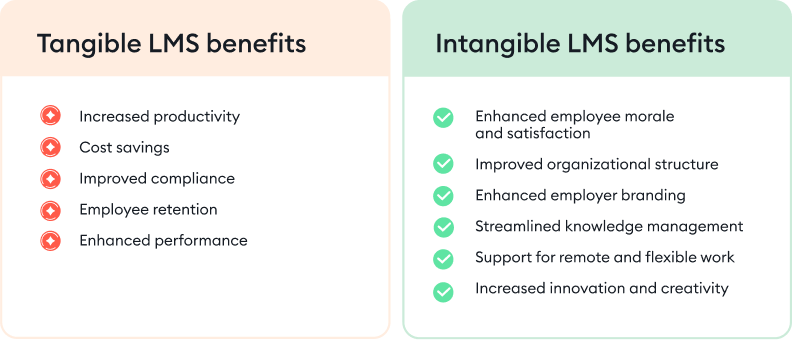
With that said, let’s move on to the tangible benefits and see how you can quantify them:
Increased productivity
By streamlining training processes, organizations can increase the overall productivity of their teams. This includes the time that learners spend taking training, as well as the time spent on training management personnel, e.g., administrators or other professionals, like team leaders or HR specialists, who fill this role.
For example, iSpring LMS automates many administrative tasks, like notifying learners of deadlines and new assignments, and checking the progress they’ve made. What otherwise would take a person several hours is accomplished automatically and doesn’t require any human involvement, which saves tons of time. And instead of going to in-person sessions that take hours or even days if the trainers have to travel, learners take short, 3-5-minute modules during their breaks or on their way home.
To calculate the changes in productivity, measure the time employees used to spend learning and managing training programs and compare it to the current metrics. Then calculate the monetary value of this saved time based on employee salaries.
Cost savings
LMS platforms reduce the need for in-person training, cutting costs related to travel, accommodation, and printed materials. If you used to provide this sort of training before going online, compare your spending from that period with your current training expenses on the same aspects.
For example, before implementing iSpring LMS, IMT Matcher used to train their customers in-person. They had to pay for their employees’ trips to each IVF lab and perform face-to-face training. By moving training online, they were able to cut their training costs by at least 25%.
Improved compliance
LMSs ensure consistent training and certification, significantly reducing the risks of non-compliance. Companies can potentially save millions of dollars annually by avoiding compliance-related fines. However, such potential figures won’t work for calculating LMS ROI.
If your company has faced compliance-related fines in the past, you can compare those expenses with the ones you have after implementing an LMS and launching effective compliance training. If not, move this benefit to the intangible column and make sure to keep it in mind when evaluating the effectiveness of your LMS. This is one of those things where no news is good news.
For example, Forever Direct reduced accidents by 50% after launching online training with iSpring LMS.
Employee retention
Better training opportunities improve employee satisfaction and consequent retention. Not all companies measure employee satisfaction regularly; that’s why it wouldn’t be correct for them to use this metric in the formula. However, employee retention rates are commonly recorded.
Organizations estimate that hiring new employees can cost 3 to 4 times their salary. This is a huge investment, and that’s why HR teams always report on how many employees stayed after the trial period. You can compare this metric with the values achieved prior to using an LMS and launching online new hire onboarding and estimate how much money the LMS saved you.
Enhanced performance
Effective training efforts lead to improved performance. Many companies that use LMSs report an increase in sales and customer satisfaction due to better-trained employees. Some LMSs, like iSpring LMS, have powerful analytics capabilities that allow you to draw connections between training and employee performance.
For instance, if you see that a salesperson shows poor results, you can first identify their strengths and points of growth using 360-degree feedback assessment and then assign them training programs to develop knowledge and skills that are lacking. Compare their results before and after training and include them in the equation.
Step 3: Calculate ROI
With both costs and benefits quantified, you can calculate the ROI using the following formula:

Where Net Benefits = Total Benefits – Total Costs.
Let’s see how it works with some examples:
Example 1: Small business
A small business spends $20,000 on LMS implementation, consisting of $5,000 for initial setup, $10,000 for customization and integration, $2,000 for training, and $3,000 for the initial annual subscription fee. The benefits include $15,000 in increased productivity, $5,000 in cost savings from reduced travel, and $2,000 in improved compliance.
Here’s what we have:
- Total costs: $20,000
- Total benefits: $22,000
- Net benefits: $2,000

So, the ROI is 10%.
Example 2: Mid-sized enterprise
A mid-sized enterprise invests $80,000 in an LMS, consisting of $15,000 for initial setup, $30,000 for customization and integration, $10,000 for training, and $25,000 for the initial annual subscription fee. The benefits include $50,000 in increased productivity, $15,000 in cost savings from reduced travel, $20,000 in improved compliance, and $15,000 in enhanced performance.
Here’s what we have:
- Total costs: $80,000
- Total benefits: $100,000
- Net benefits: $20,000

So, the ROI is 25%.
And that’s it! By following these steps and using the provided data, you can calculate the accurate ROI of your LMS investments.
4 Key Factors Affecting LMS ROI
Once you’ve measured the ROI of your LMS, you might want to better understand why you got this result — what affected it and how you can optimize it. Here are some factors to consider:
#1: Implementation costs
The initial costs of implementing an LMS can vary widely. Factors such as the complexity of the system, the need for customizations, and the scale of deployment can impact the overall investment significantly. Proper planning and customer success support from the vendor can help control these costs.
#2: Training and support
Employee training and ongoing support are critical for maximizing LMS ROI. Adequate training ensures that users can get the most out of the platform, leading to better performance and a higher ROI. Continuous support from your LMS provider helps address any issues, sustaining the system’s effectiveness. That’s why, at iSpring, we provide 24/7 live tech support to all our clients.
#3: Learner engagement
High learner engagement is essential for realizing the full benefits of an LMS. Encouraging employees to actively participate in an online training program and use the LMS’s capabilities to upskill and connect with their team enhances the ROI significantly. Engaged users are more likely to complete courses and apply their knowledge to their work.
#4: Integration with other systems
An LMS that integrates with other management systems, like HR and ERP, can provide additional benefits by streamlining processes and improving data accuracy. This integration can reduce administrative burdens and enhance the overall efficiency of training programs, contributing to a higher ROI.
Summing Up
Measuring the ROI of an LMS is crucial to demonstrating its value and making informed decisions about training investments. By understanding how to calculate ROI and the factors that influence it, organizations can maximize the benefits of their LMS and ensure they are getting the best return on their investment.
Be sure to download our LMS ROI calculator template to measure the ROI of your LMS investment. It’s free!
If you haven’t found an LMS that best suits your needs and gives the best ROI, check out iSpring LMS. Unlike most alternatives, it comes with an authoring tool and powers the full training cycle, from creating high-quality training content to analyzing the effectiveness of your training.
So, by simply selecting iSpring LMS, you’re already saving on any third-party solutions, like an authoring tool for creating courses, that you would have to purchase separately when opting for other LMS options.
Try it out. Get started with iSpring LMS right now for free.

